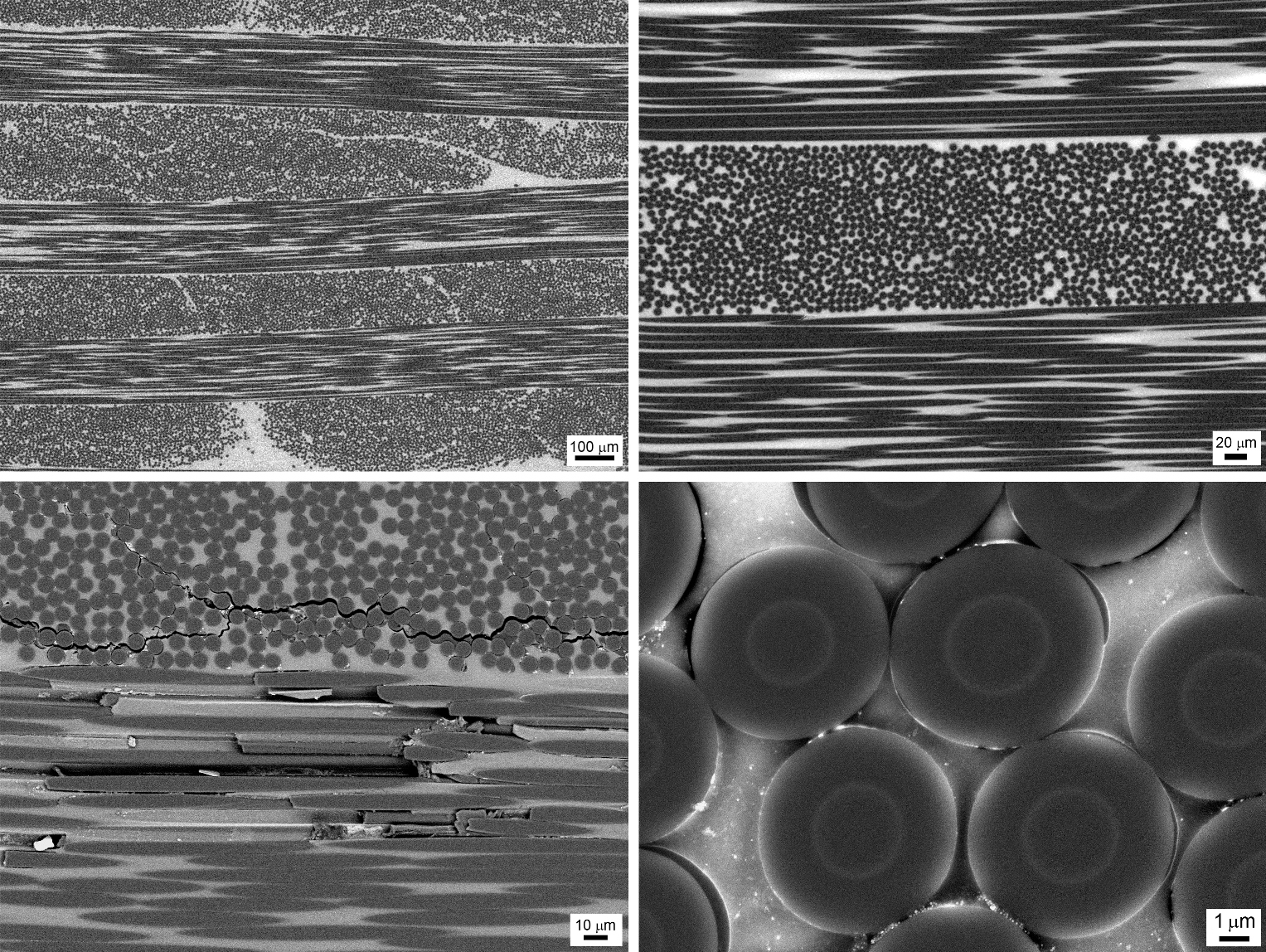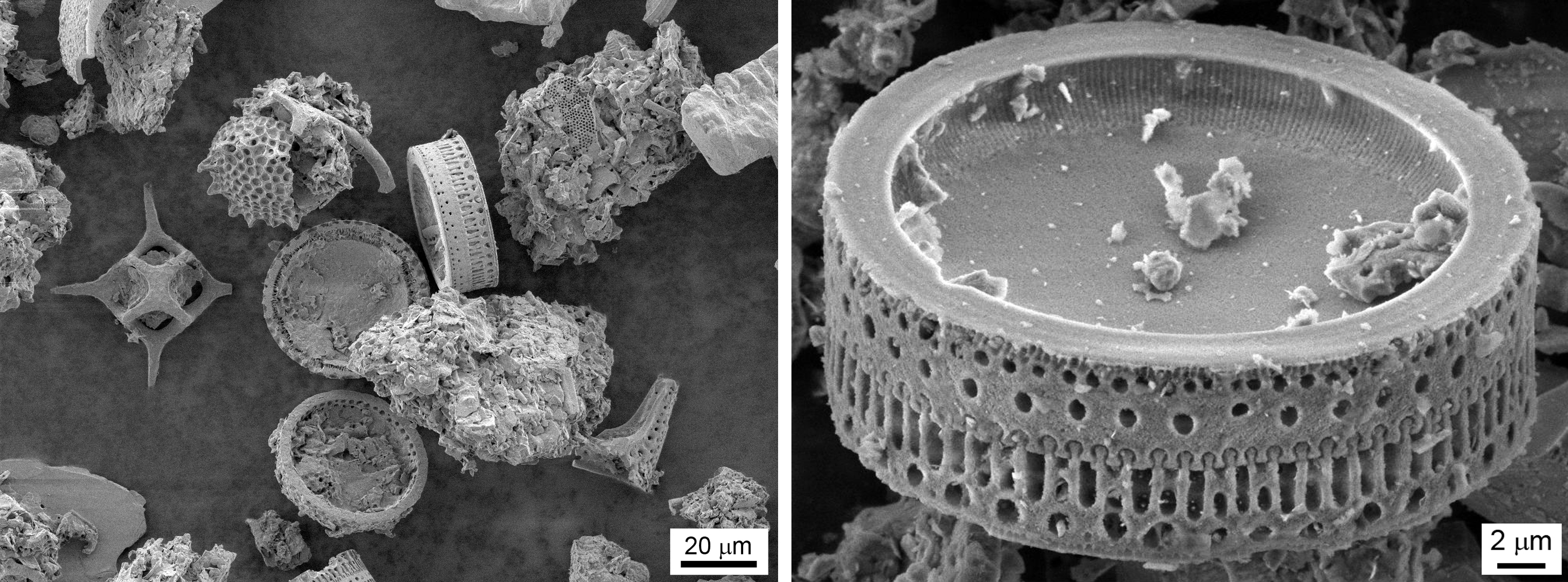Inside view: the world around us - 4

In a previous article, among other things, it was mentioned that it was time to complete the epic with writing articles about the microworld that surrounds us everywhere, but that wasn’t ...
One of my colleagues in electron microscopy, Andrei Burmistrov (@Venelt), who works with a serious Tescan microscope , periodically publishes magnificent images of microscopic objects, both living and non-living, on the Nanometer.ru website . And I wanted to share this beautiful world with respected Habrausers, let's go ?!
Non-living matter
Let's start with inanimate nature.
Carbon New reading
In one of the articles I have already published photos of carbon fiber or in the vernacular «carbon fiber’, but I think it will not be superfluous to repeat myself, especially since the photographs presented below were taken “correctly”, with appropriate sample preparation.

“Correct” carbon fiber micrographs
These photographs are noteworthy because they were obtained using a BSE ( back-scattered electrons ) detector, which makes it possible to see, for example, that the fiber inside is heterogeneous and consists of a core and a shell, which is apparently due to annealing conditions fiber.
Spark lighters
I don’t think anyone ever thought that every teal of a lighter produces a huge amount of tiny micro and even sometimes nanoparticles scattering in all directions. Often they take on completely bizarre shapes depending on the formation conditions, such as these:

But, in my opinion, the particles are more interesting, which during their short but vibrant life crystallized, forming a unique ornament, according to which, in principle, their phase composition can be suggested:

Images obtained using a BSE detector that provides information on the chemical contrast of the material (darker areas correspond to lighter elements)
But this is not all, due to the development of computing power of computers and processing electronics inside modern microscopes, it is now possible to obtain 3D (stereo pair) images of objects in one click. Electronics simply deflects the electron beam by which the surface is scanned by a given angle (usually 15-20 degrees), and then automatically combines two images:

Example of using 3D in modern electron microscopy (glasses with a red and blue filter are required)
Toner
On Habrahabr, sometimes scanned photos of the toner obtained using scanning electron microscopy (for example, a post from Kyocera ). I hasten to supplement these wonderful shots:

Spherical particles of printer toner usually do not exceed a few microns, so they are so difficult to remove if you get dirty
Track membranes
The track membrane is a rather specific and outlandish thing. If you don’t go into much detail, you can get it by exposing (or exhibiting) a thin polymer film of only a few tens of microns under the action of ionizing radiation, for example, alpha particles (or accelerated ions of inert gases). Penetrating through the film, alpha particles or ions fly right through their mass and speed, leaving a track - a kind of well in diameter from a few nanometers to several microns (depending on the processing process).
After processing, such a sieve can be used for filtering water, dialysis, thin air purification for clean rooms, and so on, until the creation of clothes (I won’t be surprised if GoreTex uses the same technology).

Dacron-based track membrane (or, simply, PET )
Living matter
Butterfly wing
When it comes to optics, photonics and related fields of science, the butterfly and its unusual wings are immediately remembered. Exclusively due to the wave properties of light, such structured wings can change their color depending on the viewing angle. A reasonable question: How is this wing arranged ?! And here is the answer:

The wing of a butterfly under a beam of an electron microscope.
As you can see, the wing has several levels of structural organization. It consists of scales, which in turn consist of furrows. And each furrow is formed by a huge number of small scales stacked in a stack, the size of which exactly coincides with the wavelengths of the visible range, so we have a diffraction grating that sets the color of the butterfly wing. Therefore, depending on the viewing angle, we see one or another color.
Web
Nobody saw this for sure, and I admit honestly, when I first looked at these photos, I just could not understand what was in front of me. But it turned out that this is just a spider web. And, perhaps, I dare to suggest that these balls (with some gummy secretion of glands, apparently) on it are places for fastening transverse threads and / or a trap for flies and other insects. The thickness of the rope for the web is about 1 micron!

Perfectly stretched strings of spider webs
Insect
Speaking of insects. It seems that in one of the early posts I was asked to show some insects under the barrel of an electron microscope. You yourself know, in Russian fairy tales it usually sounds like this: “How long, how short ...”
In general, meet our guest - Mukha-Tsokotuha. It’s necessary to check with Andrei, but it’s possible that she became a victim of spider-like webs ... A

fly under a microscope and her faceted eyes
Usually, from childhood we are instilled with hostility to various kinds of insects, including flies, supposedly if the fly sat on some kind of object, then before use it must be washed again. Now you, dear readers, have a clear confirmation of this - a lot of particles of dirt and possibly bacteria on the legs of an insect:

An enlarged foot of a fly and dirt on it
Radiolarians
And finally, today's release completes another unusual object that surrounds us everywhere in the warm waters of the oceans - unicellular plankton or radiolarians . In principle, unicellular and unicellular - nothing special, if not for their skeleton, which, by the way, after the death of these forms the bottom sediments ...

Constructor "Radiolaria" - collect what you can!
Sometimes almost uncorrupted specimens of the most bizarre forms come across in samples:

Well preserved during transportation from the warm seas to Moscow
And a little intrigue in the REN-TV style: it seems to me that the ancient Romans possessed an electron microscope and observed the idea of the Colosseum in nature, that is, they were the founders science biomimetics(a joke, of course, but involuntarily you begin to think): The

Colosseum is now everywhere in the oceans!
Finally - a journey from a millimeter to a micrometer - from a crustacean to a diatom and then to bacteria:

PS: We can also say thanks to the author of the Venelt photos .
Firstly , the full list of published articles “Inside View” on Habr:
Opening the Nvidia 8600M GT chip , a more detailed article is given here: Modern chips - inside view Inside
view: CD and HDD
Inside view: LED bulbs
Inside view: LED industry in Russia
Inside view: Flash memory and RAM
Inside view: the world around us
Inside view: LCD and E-Ink displays
Inside view: digital camera arrays
Inside view: Plastic Logic
Inside view: RFID and other marks
Inside view: graduate school in EPFL. Part 1
Inside Look: Graduate School at EPFL. Part 2
Inside Look: The World Around Us - 2
Inside view: the world around us - 3
Inside view: the world around us - 4
Inside view: 13 LED lamps and a bottle of rum. Part 1
Inside view: 13 LED lamps and a bottle of rum. Part 2
Inside view: 13 LED lamps and a bottle of rum. Part 3
Inside Look: IKEA LED Strikes Back
Inside Look: Are Filament Lamps So Good?
and 3DNews:
Microview: comparing displays of modern smartphones
. Secondly , in addition to the HabraHabr blog , articles and videos can be read and viewed on Nanometer.ru , YouTube , and Dirty .
Sometimes you can read briefly, and sometimes not so much about the news of science and technology on my Telegram channel - we ask you;)
